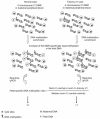Fetal-specific DNA methylation ratio permits noninvasive prenatal diagnosis of trisomy 21
- PMID: 21378977
- PMCID: PMC3977039
- DOI: 10.1038/nm.2312
Fetal-specific DNA methylation ratio permits noninvasive prenatal diagnosis of trisomy 21
Abstract
The trials performed worldwide toward noninvasive prenatal diagnosis (NIPD) of Down's syndrome (or trisomy 21) have shown the commercial and medical potential of NIPD compared to the currently used invasive prenatal diagnostic procedures. Extensive investigation of methylation differences between the mother and the fetus has led to the identification of differentially methylated regions (DMRs). In this study, we present a strategy using the methylated DNA immunoprecipitation (MeDiP) methodology in combination with real-time quantitative PCR (qPCR) to achieve fetal chromosome dosage assessment, which can be performed noninvasively through the analysis of fetal-specific DMRs. We achieved noninvasive prenatal detection of trisomy 21 by determining the methylation ratio of normal and trisomy 21 cases for each tested fetal-specific DMR present in maternal peripheral blood, followed by further statistical analysis. The application of this fetal-specific methylation ratio approach provided correct diagnosis of 14 trisomy 21 and 26 normal cases.
Figures



Comment in
-
A new era of non-invasive prenatal genetic diagnosis: exploiting fetal epigenetic differences.Clin Genet. 2012 Apr;81(4):362-3. doi: 10.1111/j.1399-0004.2011.01835.x. Epub 2012 Jan 16. Clin Genet. 2012. PMID: 22171618 No abstract available.
-
Technical concerns about immunoprecipitation of methylated fetal DNA for noninvasive trisomy 21 diagnosis.Nat Med. 2012 Sep;18(9):1327-8; author reply 1328-9. doi: 10.1038/nm.2915. Nat Med. 2012. PMID: 22961155 No abstract available.
Similar articles
-
Variability of ffDNA in maternal plasma does not prevent correct classification of trisomy 21 using MeDIP-qPCR methodology.Prenat Diagn. 2013 Jul;33(7):650-5. doi: 10.1002/pd.4140. Epub 2013 May 28. Prenat Diagn. 2013. PMID: 23619923
-
MeDIP real-time qPCR of maternal peripheral blood reliably identifies trisomy 21.Prenat Diagn. 2012 Oct;32(10):996-1001. doi: 10.1002/pd.3947. Epub 2012 Jul 26. Prenat Diagn. 2012. PMID: 22833530
-
Technical concerns about immunoprecipitation of methylated fetal DNA for noninvasive trisomy 21 diagnosis.Nat Med. 2012 Sep;18(9):1327-8; author reply 1328-9. doi: 10.1038/nm.2915. Nat Med. 2012. PMID: 22961155 No abstract available.
-
Systematic review of noninvasive prenatal diagnosis for abnormal chromosome genetic diseases using free fetal DNA in maternal plasma.Genet Mol Res. 2015 Sep 9;14(3):10603-8. doi: 10.4238/2015.September.9.1. Genet Mol Res. 2015. PMID: 26400291 Review.
-
Noninvasive prenatal diagnosis of Down syndrome: current knowledge and novel insights.J Perinat Med. 2012 Feb 13;40(4):319-27. doi: 10.1515/jpm-2011-0282. J Perinat Med. 2012. PMID: 22752761 Review.
Cited by
-
Prenatal testing for intellectual disability: misperceptions and reality with lessons from Down syndrome.Dev Disabil Res Rev. 2011;17(1):27-31. doi: 10.1002/ddrr.135. Dev Disabil Res Rev. 2011. PMID: 22447752 Free PMC article. Review.
-
DNA methylation as clinically useful biomarkers-light at the end of the tunnel.Pharmaceuticals (Basel). 2012 Jan 18;5(1):94-113. doi: 10.3390/ph5010094. Pharmaceuticals (Basel). 2012. PMID: 24288045 Free PMC article.
-
Myeloid leukemia in Down syndrome.Crit Rev Oncog. 2011;16(1-2):25-36. doi: 10.1615/critrevoncog.v16.i1-2.40. Crit Rev Oncog. 2011. PMID: 22150305 Free PMC article. Review.
-
Evidence for widespread changes in promoter methylation profile in human placenta in response to increasing gestational age and environmental/stochastic factors.BMC Genomics. 2011 Oct 28;12:529. doi: 10.1186/1471-2164-12-529. BMC Genomics. 2011. PMID: 22032438 Free PMC article.
-
Non-invasive prenatal diagnosis of fetal trisomy 21 using cell-free fetal DNA in maternal blood.Obstet Gynecol Sci. 2013 Mar;56(2):58-66. doi: 10.5468/OGS.2013.56.2.58. Epub 2013 Mar 12. Obstet Gynecol Sci. 2013. PMID: 24327983 Free PMC article. Review.
References
-
- Hulten MA, Dhanjal S, Pertl B. Rapid and simple prenatal diagnosis of common chromosome disorders: advantages and disadvantages of the molecular methods FISH and QF-PCR. Reproduction. 2003;126:279–297. - PubMed
-
- Lo YM, et al. Presence of fetal DNA in maternal plasma and serum. Lancet. 1997;350:485–487. - PubMed
-
- Honda H, et al. Fetal gender determination in early pregnancy through qualitative and quantitative analysis of fetal DNA in maternal serum. Hum. Genet. 2002;110:75–79. - PubMed
-
- Bianchi DW, Avent ND, Costa JM, van der Schoot CE. Noninvasive prenatal diagnosis of fetal Rhesus D: ready for Prime(r) Time. Obstetrics and gynecology. 2005;106:841–844. - PubMed
-
- Lo YM, et al. Prenatal diagnosis of fetal RhD status by molecular analysis of maternal plasma. The New England journal of medicine. 1998;339:1734–1738. - PubMed
Publication types
MeSH terms
Substances
Grants and funding
LinkOut - more resources
Full Text Sources
Other Literature Sources
Medical

